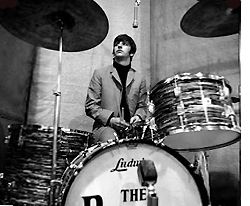Recently I talked about how to go really old school and record the drums with a single mic.
Today we’ll come into the future just slightly and look at how it was done with two mics.
This was the sound of many of those great hits from The Beatles, Led Zeppelin, Beach Boys, etc., at least in the beginning of their careers.
If you look at pictures of recordings in the early to mid 1960s, you’ll always see the drums mic’ed with one mic on the kick drum and another used as an overhead.
Here’s the placement technique:
1) Place the kick drum mic about a foot away from the outside of the front of the drum (it doesn’t matter whether it has a front head on or not).
Place it at about the height of the beater and aim it towards where the beater hits.
2) Place the overhead mic over the center of the kit (where the rack tom or toms and the snare meet) at height of just a little over the top of the drummer’s head. Raise it up a little if you’re not getting the coverage of the kit that you need.
You also might want to shade it a bit more towards the floor tom, since that’s the drum that’s usually picked up the least in this setup.
Keep in mind that the 2-mic setup works best for small kits like they used in the 60s. If you have a huge Terry Bozzio-like kit with a dozen toms and cymbals, you won’t get the result you’re looking for with this method.
Also keep in mind that the 2-mic method was always used for mono recording where both mics were recorded on a single track, and sometimes, were mixed together with other instruments as well (or even a lot of other instruments, like in the case of Phil Spector’s “Wall of Sound”).
That doesn’t mean that you have to record both mics on the same track, but they were forced to way back when because they didn’t have the technology available to them to separate things a bit to balance them later.
Remember that a little bit of compression (a couple of dB or so, but add to taste) goes a long way in this setup, helping to balance the kit a bit while moving it forward in the mix.
So if you want a simple setup that gets an authentic “classic 60s” drum sound with a minimum of hassle, the 2-mic method is the way it was done.
Bobby Owsinski is an author, producer, music industry veteran and technical consultant who has written numerous books covering all aspects of audio recording. For more information be sure to check out his website and blog.





















